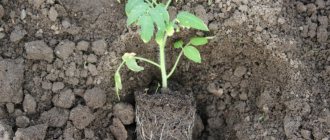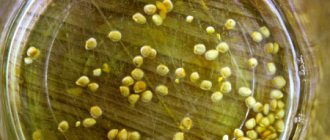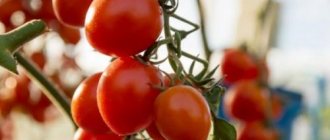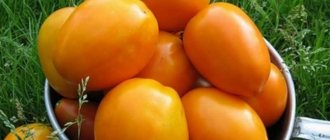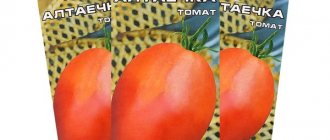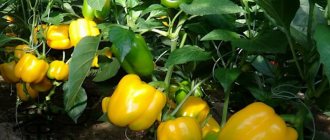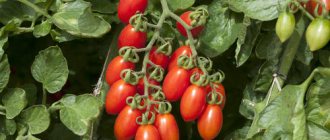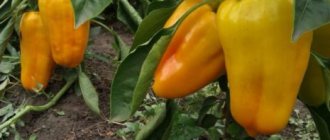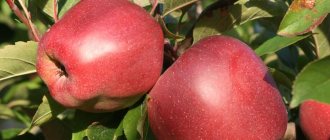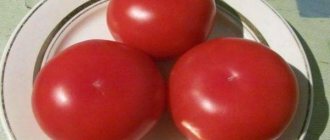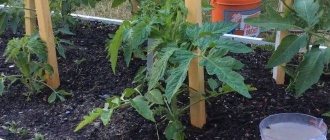Description of the series of varieties
Description and reviews of Tomato De Barao report that it belongs to the medium-late indeterminate tomatoes, requiring 115-125 days to ripen. All this time, the stem continues to grow upward (reaches 4 m in height) until the plant stops bearing fruit. It is recommended to pinch the top when it reaches 2 m in height. The optimal climate for cultivation is the southern regions of the country, and in the middle zone, the Moscow region and more northern regions, greenhouse cultivation is used.
The leaves are large and pubescent, as is the stem. Inflorescences are formed with a large number of ovaries, and the stalk necessarily has articulations. The first brush is formed after the 9th sheet, and then every 3 sheets.
The fruits are plum-shaped with a pointed nose, and the color can be red, yellow, pink, orange and even black. On 1 or 2 stems, long clusters of 5-7 or more fruits are formed on each, and on average up to 10 clusters ripen on 1 bush. The tomatoes are very dense, which allows them to be stored fresh for up to 2 months. Inside each there are 2 chambers filled with seeds. The average dry matter content is about 5%.
Tomato De Barao black
The mid-season tomato De Barao black, judging by reviews and photos, ripens on average in 115-130 days. The oval-shaped fruits, 40-70 g each, become dark in color with a reddish tint as they ripen. On average, 1 bush 2.5-3 m high yields up to 8 kg, and when planted at a density of 2 plants per 1 m2, the yield reaches 15 kg. It is consumed mainly fresh, and is also used for pickling as a whole.
Tomato De Barao red
A mid-late variety, growing 2.5-3 m in height, registered in Rosreestr in 1998. It takes 120-130 days for the crop to ripen. The fruits have a bright scarlet color, oval shape and an average weight of 80-120 g; up to 6 kg are collected from the bush. Gardeners prefer to use fresh tomatoes, as well as can them whole. It is almost unsuitable for making ketchup or juice due to its high density and low juiciness. It is grown in open ground in the Krasnodar Territory, Astrakhan, in the Crimea, and in other regions - in greenhouses and hotbeds.
Tomato De Barao pink
According to the description of the De Barao pink tomato variety, unlike its relatives, it has a slightly smaller height - on average 1.7-2 m. 1 bush can produce up to 10 kg in a greenhouse, but in open ground they usually harvest about 6-7 kg per 1 plants. Each branch (and there are 1-2 of them on a bush) forms 4-6 brushes, on each of which 8-10 tomatoes weighing 80-100 g ripen. Plum-shaped fruits with an indispensable sharp nose are colored dark pink or pink-red. , ripen in 111-119 days.
Tomato De Barao Giant
The characteristics of the De Barao Black Giant tomato indicate: this variety produces the first tomatoes after 123-128 days from germination. It is grown in hotbeds and hothouses, with the exception of the southern regions, where these tomatoes have time to ripen during the long summer. Depending on the growing conditions, the bushes stretch up to 190-270 cm in height. Plum-shaped, rounded fruits with a spout have an average weight of 350 g and are bright red in color with a green spot at the stalk. They are used not only for pickling and fresh, but also for the production of ketchups and sauces. Tomato De Barao Giant, judging by reviews and photos, has a yield of up to 22-23 kg. The recommended planting density is up to 3 bushes per 1 m2.
Tomato De Barao Tsarsky
The variety is distinguished by powerful indeterminate bushes up to 1.5-2 m high. The yield reaches 10-15 kg per bush in 110-120 days. Medium-sized fruits - 150-170 g each. The color is red with a pinkish tint. The shape is oval-elongated with a sharp nose. Whole grains are processed for canning, tomato paste and ketchup. The taste is sweet and sour, great for salads.
Tomato De Barao Golden
Received its name for the sunny yellow color of tomatoes. The ripening period is slightly shorter than that of analogues - 110-120 days. The height of the bushes is up to 2 m. The yield does not exceed 12 kg per plant in open ground, but in a greenhouse you can achieve 20 kg. The fruits are 80-90 g, elongated, round with a spout. Tomatoes are mostly consumed fresh. They are great for prefabricated canning as a whole, which only decorates jars of pickles.
Tomato De Barao orange
Medium ripening variety – up to 110-130 days. Bushes are formed up to 2 m in height. The average yield per plant does not exceed 8-9 kg, but in greenhouses with abundant feeding it increases to 10-12 kg. The tomato weighs up to 120 g, has a bright orange orange color, a strong pleasant aroma, and a plum-shaped shape. Preferred use is for whole canning. Its high shade tolerance allows it to be planted along fences and under trees.
Productivity
The variety "De Barao gold" is characterized by high yield. The harvest from each bush reaches from 8 to 12 kg of tomatoes.
REFERENCE: Good climatic conditions and rich regular fertilizing help increase the yield up to 20 kg. Obtaining a guaranteed tomato harvest in the Far East and in the regions of Siberia is only possible when the variety is grown in greenhouse conditions.
Which regions are best to grow in?
Thanks to its excellent tolerance to frost and drought, the variety is not afraid of temperature changes. This advantage allows tomatoes to be grown in almost all regions except the coldest. The Rostov and Belgorod regions, Kuban, Caucasus and Crimea are suitable for growing in open ground.
Comparative characteristics of the variety series
| Variety name | Weight of 1 fruit, g | Bush height, m | Maturation period, days | Productivity per plant |
| Tomato De Barao black | 40-70 | 2,5-3 | 115-130 | 8 |
| Tomato De Barao red | 80-120 | 2,5-3 | 120-130 | 6 |
| Tomato De Barao pink | 80-100 | 1,7-2 | 111-119 | 6-10 |
| Tomato De Barao Giant | 350 | 1,9-2,7 | 123-128 | 22-23 |
| Tomato De Barao Tsarsky | 150-170 | 1,5-2 | 110-120 | 10-15 |
| Tomato De Barao Golden | 80-90 | 2 | 110-120 | 12 |
| Tomato De Barao orange | 120 | 2 | 110-130 | 10-12 |
Productivity and fruiting
The weight of 1 tomato ranges from 70-120 g. The purpose is universal, but for the most part small tomatoes are used for canning as a whole. The yield from 1 m2 reaches 40 kg, and on average up to 12-15 kg are harvested from 1 bush. It is not greatly influenced by the choice of type of cultivation - open or closed ground, but in greenhouses it is possible to collect more, including green fruits. The harvest begins in mid-summer and continues until frost. Maturation is unfriendly, and in tiers: from bottom to top.
Area of application of fruits
The variety is widely used in private and industrial plant growing. It is often planted for technical purposes, for fresh sale, as well as for processing into tomato paste and whole canning. Not suitable for juices because the tomatoes are not very juicy. They are good when whole pickled because the skin does not crack. When grown in private greenhouses, even green unripe fruits are collected, which can be ripened perfectly in the light in warm rooms.
Resistance to diseases and pests
The variety is resistant to late blight. It cannot resist attack by the Colorado potato beetle and slugs, therefore it requires appropriate treatments when there is a threat of pest invasion. Among the common diseases typical of De Barao is bacterial black spot. The planting is treated with the drug “Fitolavin”. To avoid damage to fruits by blossom end rot, it is not recommended to flood the bushes, but for prevention, spray them with calcium nitrate a couple of times a season.
Advantages and disadvantages of the variety
Over the years of growing De Barao, gardeners have noted the following advantages:
- No special care required.
- Plants are shade-tolerant.
- Cold resistance and drought resistance.
- High and stable yield even in cloudy summers.
- Resistance to nightshade diseases, including late blight.
- Keeping quality – up to 2 months.
No particular shortcomings were noted. It's just a neutral taste, not particularly acidic or sweet.
Characteristics of De Barao
- The variety is considered late ripening. Approximately 110 days pass from germination to ripening;
- The harvest is always stable. From 1 sq. meter, up to 7 kg of ripe fruits are easily collected;
- Fruiting occurs until the first frost;
- Good adaptation to growing conditions. Good stress tolerance, no fear of cold and frost, poor lighting is not a hindrance;
- During long rains, the peel never bursts;
- Disease resistant. But sometimes it can become infected with late blight;
- Due to the strength of the peel, it can be transported to any distance, even the farthest;
- The keeping quality is simply excellent. If storage standards are followed, the presentation can be preserved for almost 60 days;
- If the fruits were picked before they were ripe, don’t worry. You just need to put them where it’s warm so that they reach condition. At the same time, taste qualities do not suffer;
- Application methods are universal. They can be used in any way: fresh, pickled, preserved. It’s just that you won’t be able to squeeze out the juice – the pulp is too dense with a small amount of liquid.
Related article:
What fertilizers do tomatoes lack?
Growing rules
Since the variety is a mid-late variety, in most parts of the country it is cultivated in greenhouses, as well as in open ground using seedlings. In this case, even in a very cloudy summer, it is possible to harvest a good harvest of tomatoes, which can ripen in a warm room.
Planting seedlings
For seedlings, prepare a common container with soil (pH 5.5) up to 20 cm high, into which seeds, previously soaked in a disinfectant solution, are sown in the first ten days of March. Shoots appear within 5-7 days. With the appearance of the first leaf, you can pick the cups.
The optimal temperature regime for De Barao tomatoes is in the range of + 20-25 0C. When hardening, before planting in open ground, you can take it out into the air, heated to at least + 10-12 0C. Caring for seedlings involves regular watering as the soil dries, as well as ensuring sufficient daylight hours (at least 8 hours). If necessary, install phytolamps.
Tomato transplant
A 60-day-old De Barao tomato seedling, which is planted in open ground, a greenhouse or a greenhouse, is considered an adult. At the planting site, supports or trellises should already be installed, to which the quickly growing stems will be tied.
The planting pattern is 1 m between rows, and per 1 m of beds – a maximum of 2 bushes. When transplanting, water moderately in the first 1-2 days so as not to flood the roots. In the future, watering is carried out as needed, making sure that the leaves on the stems do not droop or wilt.
Subsequent care for tomatoes
All varieties of De Barao tomatoes require constant pinching. Every 10 days it is necessary to go around the planting, find and remove newly appeared stepsons. From the growth point, leave 1 main branch, or 2. The top is pinched after the stem has grown to 2 m. Therefore, regardless of the choice of planting site (greenhouse or open ground), trellises must be installed for tying. From the last brush to the crown it is allowed to leave up to 8 leaves.
To prevent too rapid evaporation of moisture, mulch is scattered along the planting line of the De Barao tomato, or a black agrofibre cover is used. Feeding is carried out according to the following scheme:
- Once every 2 weeks, when watering, add a solution of superphosphate: 20 g per 10 liters of water.
- Once a week, water with a solution of mullein (1:6) or chicken manure (1:20).
- It is recommended to periodically water with nettle infusion. The green tops are filled with water and left for a couple of days, and then the drained liquid is used as top dressing.
Pest and disease control
The main method of combating diseases common to all nightshades is spacious planting, when the bushes do not shade each other. In this case, good natural ventilation is provided for all varieties of De Barao tomatoes, with a lack of which there is a rapid growth of foci of fungal and other diseases.
Tomatoes need regular watering, but do it strictly on the ground (without spraying the foliage) in the morning or evening. Moisture on the tops becomes a favorable environment for the adhesion of spores of pathogenic fungi and mold, and can also cause sunburn.
It is recommended to treat the Colorado potato beetle with Prestige. And if there are too many beetles, they are collected by hand and then destroyed. Treating the ground around the bushes with solutions containing hot pepper or mustard, as well as sprinkling with wood ash, helps against slugs.
Advantages and disadvantages
Most experienced gardeners can find De Barao red tomatoes in their plots. The reasons for this are the impressive list of advantages of the variety.
Black spot is the main enemy of De Barao tomatoes
pros
- low maintenance;
- high productivity;
- frost resistance;
- drought resistance;
- extended shelf life;
- keeping quality;
- transportability;
- possibility of ripening;
- good immunity.
Minuses
- weak resistance to fungal diseases;
- susceptibility to attacks by the Colorado potato beetle (in the absence of preventive treatment).

